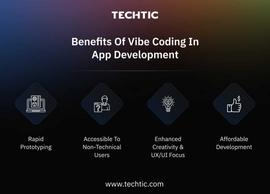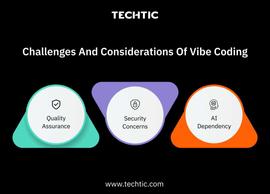What Is Vibe Coding? How AI and Natural Language Are Redefining App Development
Sector: Technology
Author: Nisarg Mehta
Date Published: 08/27/2025

Contents
Vibe coding is shaking up how we think about software. Picture this: instead of slogging through endless lines of code, you just tell an AI what kind of app you want, in plain language. A few seconds later, boom, it spins out working code for you. That’s the magic of vibe coding. Developers (and even non-developers) can sketch out big ideas without getting stuck in syntax and brackets.
That’s what makes vibe coding so intriguing, it feels less like programming and more like collaborating. You’re providing the ideas, the vision, the personality of the app. The AI handles the technical grind: connecting databases, shaping the interface, ensuring the logic flows.
How Vibe Coding Works
Let’s see vibe coding in action:
A. From Prompt to Code
Vibe coding is surprisingly easy but packs a punch. Instead of getting stuck wrestling with complicated code syntax, you just explain what you want the app to do, in plain English. Then AI tools like GPT-5 or Claude take over and write the code for you.
You can simply say “Create a social networking mobile app with user authentication, a news feed, and a messaging system.” The AI coding platform then generates everything from the database to the UI components. Isn’t it cool?
B. The Role of AI Models
To understand vibe coding, it’s essential to know the role of AI models like GPT-5, Claude, and Sonnet. These large language models (LLMs) are trained to understand vast amounts of data, including the syntax, logic, and structure of code. But they don’t stop there, these models can interpret natural language instructions and translate them into executable code.
For example, if prompted to create a social application with authentication, content sharing, and real-time interaction, such models can immediately generate the foundation of a production-ready platform. What traditionally consumed weeks of developer effort can now be delivered in a fraction of the time.
C. Iterative Process
Here’s where vibe coding truly shines. Vibe coding thrives on iteration. If something feels off, you simply refine your request and let the AI try again. That flexible loop makes trying wild ideas painless, you can throw concepts at the wall, see what sticks, and keep evolving, without ever touching a single “if-else” statement.
Top Vibe Coding Tools in 2025
It’s 2025, and there are several tools developers are using to build astonishing software solutions and apps via AI. Here are the top ones:
Lovable
Lovable is widely regarded as the easiest vibe coding tool for beginners. Reviewers praise its smooth approach to generating full-stack apps without needing coding knowledge. The platform sketches and explains every step, offering clear control for both frontend and backend. Users appreciate its integration with Supabase and GitHub, which provides decent security and convenient exporting. The main drawback is Lovable’s high credit usage rate and limitations on the free plan, but most testers felt it struck the best balance for first-time vibe coders.
In our hands-on usage, we found that Lovable’s starting design is generally smooth, the functionality works well, and the early stage of the building journey doesn’t have glaring bugs or issues. … Lovable takes care of the design of the frontend and integrates with Supabase, a backend tool, to handle user authentication and data storage.
Cursor
Cursor positions itself as the ultimate debugging partner for vibe-coded projects. Reviews highlight its AI chat’s mix of brevity and depth, making it ideal for refining apps after initial vibe coding on other platforms. It reads your codebase, provides detailed improvement suggestions, and lets you accept or reject real-time code changes. Testers say Cursor is best for developers familiar with code who want precise control, as it requires manual setup and local previews. While its UX can feel complex, it’s praised for turning every coding problem into a learning opportunity and providing robust support for performance, security, and code quality.
Bolt
Bolt is popular for its playful interface and creative approach, making vibe coding feel like rapid brainstorming with a junior developer. Users say Bolt’s completions are expressive and useful for design-focused sites and quick prototyping. The platform integrates with commonly used tools and supports in-app code changes and debugging. However, reviewers note its context sensitivity is still evolving, and it may not suit deep backend tasks where accuracy is crucial. Bolt is regularly recommended for building landing pages, internal tools, or small apps, with its strengths lying in speed and the usability of exported code.
Replit
Replit is praised for its collaborative features and flexibility, especially for advanced users or more creative builds. The AI generates a plan that acts as a visual reference and tracks progress. Users note it excels during pair coding and fast prototyping, but deep focus work may be affected by a busy UI. While it’s less beginner-friendly than Lovable, its analytics and real-time features get positive reviews in team environments.
Benefits of Vibe Coding in App Development
Is it really worth it? Let’s find out:

Faster Prototyping
One of the main draws of vibe coding is how quickly you can try out ideas. Usually, building an app from scratch takes time and a fair bit of teamwork, but vibe coding really speeds things up. Tasks that would drag on for months often get done in a matter of days.
Suppose you’re refining a startup pitch and want to show off a prototype. Before, your tech team might’ve spent weeks to get a barebones version running, just to see if the idea sticks. With vibe coding, the first version can be ready surprisingly fast. It makes it easy to share concepts, collect feedback, and tweak the design, all without slowing down.
No Technical Background Required
Vibe coding helps bridge that gap between great app idas and software skills. More folks can get in on software development, entrepreneurs, small business owners, even designers, without having to learn programming first.
Think about a shop owner who wants a simple app or a content creator dreaming up a new tool. As long as they can frame their vision, the technical side is handled for them. That sort of access just wasn’t possible before.
Creativity and Focus on UX/UI
There’s another upside, too: with less time spent on routine code and tricky logic, more attention goes toward what users actually see and touch. Developers can focus on the interface, smooth interactions, and whatever features set the app apart.
There’s just something about an app that feels right when people can jump in and use it without thinking too hard. The technical side is there, sure, but it’s those little choices in design you remember after the fact, not all the background code.
Cost-Effective Development
One more thing: vibe coding has changed who can actually get apps off the ground. Used to be, building something meant putting together a full roster of specialists, which wasn’t cheap. Lately, though, even small teams, or sometimes just one really motivated person can pull it off without spending a fortune. Letting AI handle the boring or repetitive tasks means you can get things finished sooner and for less money.
Challenges and Considerations of Vibe Coding
It’s not without the challenges, but there are workarounds:

Quality Control
AI isn’t flawless, it can miss some details or make odd decisions if left unchecked. Developers have to look over the code, make improvements, and make sure everything works as planned. AI is great for getting things started, but it’s still up to real people to polish the app. Fixing bugs, making the code run smoothly, and updating it over time all need a human touch.
That’s where experts like Techtic solutions come into picture. We help you create and publish top class apps that perform without any issue.
Security
Security’s one area that deserves extra caution. Because Artificial Intelligence ( AI ) “learns” by studying what’s already out there, every so often it inherits old problems or forgets a security check or two. Anyone using AI-generated code should give it a close inspection, double-check the safety basics, and not assume everything’s foolproof the first time.
AI Dependence
There’s also the matter of balance. If teams rely on AI for everything, they might get rusty with hands-on coding or miss out on learning new things. As projects get trickier, those skills become more important. The best results tend to come when people and AI work together, using technology where it helps, but not letting it take over completely.
The Future of Vibe Coding and AI in App Development
Everyone sees a bright light ahead:
What’s Next for Vibe Coding?
As AI keeps evolving, it’s likely we’ll see it tackling trickier requests, even the kind where you just explain your idea out loud and, before long, see it take shape as a real app on your screen. The thought of building something just by talking it through doesn’t sound all that far away anymore.
Collaborative Development
And as these tools keep getting better, teams will be able to put together apps that feel smarter and fit what people want most. Chances are, developers and AI will be working side by side for a while yet, AI does the repetitive parts, leaving more room for creativity where it counts.
Learning Through AI
AI platforms aren’t just about building apps, they’re also great for folks learning how all of this works. Newcomers can experiment by giving simple instructions and see how those directions turn into working programs. For people trying to get the hang of coding, that kind of live, no-pressure feedback can make a real difference.
More Advanced Platforms
Looking ahead, vibe coding tools are set to get even more ambitious. It wouldn’t be surprising to see platforms mixing AI with things like augmented reality or machine learning. As those possibilities widen, what you can create gets bigger and smarter, and vibe coding will become even more open to everyone, not just a handful of experts.
Conclusion
Vibe coding really has flipped the script for app building. Now, anyone with a good idea can describe what they want, let the AI handle the code, and watch an app take shape. That’s more than just speeding things up, it’s opening the doors for folks who never dreamed they could build software.
Whether you’re a pro wanting to move faster or someone without a tech background just curious to try, the sky’s pretty much the limit. As AI pushes forward, vibe coding is set to be a big part of how apps get made from now on.
FAQs
Q: What is vibe coding in app development?
Vibe coding is a new way of building apps where developers (and even non-developers) use natural language prompts instead of traditional programming. You simply describe the kind of app you want in plain English, and AI tools like GPT-5, Claude, or Lovable generate the code, connect the backend, and design the interface. This makes app development faster, more intuitive, and accessible to people without coding skills.
Q: How does vibe coding work?
Vibe coding works by translating natural language instructions into executable code through AI-powered large language models (LLMs). For example, if you say, “Create a mobile app with login, chat, and a news feed,” the AI understands your request and produces the necessary code, database structure, and UI components. You can refine results by iterating your prompts until the app looks and functions the way you want.
Q: What are the top vibe coding tools?
Some of the best vibe coding platforms in 2025 include:
- Lovable – beginner-friendly full-stack builder.
- Cursor – great for debugging and refining AI-generated code.
- Bolt – ideal for fast prototyping and design-focused apps.
- Replit – excellent for collaboration, pair coding, and advanced builds.
Q: What are the main benefits of vibe coding?
The biggest advantages of vibe coding are:
- Faster prototyping – weeks of work done in days.
- No coding background needed – anyone can build apps.
- More creativity – focus on UX/UI instead of syntax.
- Cost savings – smaller teams can create production-ready apps.
Q: Can non-programmers use vibe coding?
Absolutely! One of the biggest advantages of vibe coding is that it empowers non-programmers to build functional apps without writing a single line of code. By using natural language commands, users can describe what they want, whether it’s a website, a mobile app, or a workflow automation, and the AI translates those instructions into working code.



